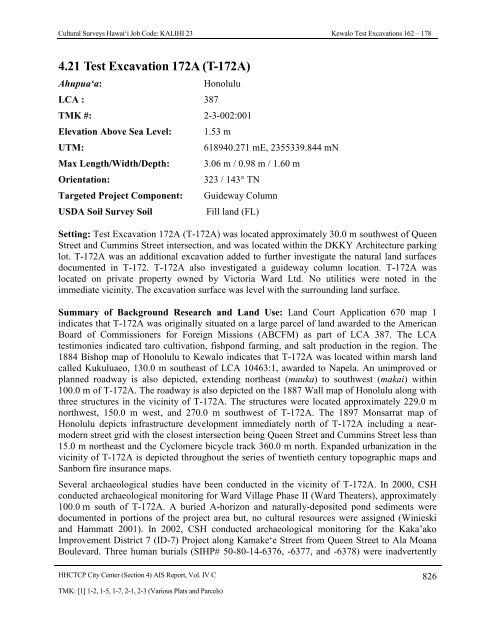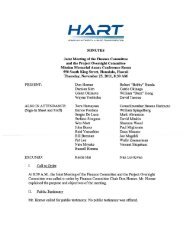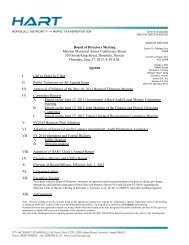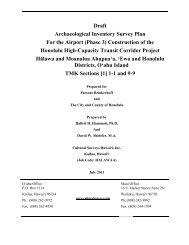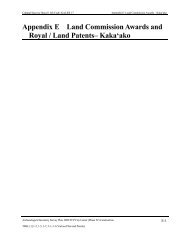4.12 Test Excavation 167 (T-167) - Honolulu Rail Transit Project
4.12 Test Excavation 167 (T-167) - Honolulu Rail Transit Project
4.12 Test Excavation 167 (T-167) - Honolulu Rail Transit Project
You also want an ePaper? Increase the reach of your titles
YUMPU automatically turns print PDFs into web optimized ePapers that Google loves.
Cultural Surveys Hawai‘i Job Code: KALIHI 23 Kewalo <strong>Test</strong> <strong>Excavation</strong>s 162 – 1784.21 <strong>Test</strong> <strong>Excavation</strong> 172A (T-172A)Ahupua‘a:LCA : 387<strong>Honolulu</strong>TMK #: 2-3-002:001Elevation Above Sea Level:UTM:Max Length/Width/Depth:Orientation:Targeted <strong>Project</strong> Component:USDA Soil Survey Soil1.53 m618940.271 mE, 2355339.844 mN3.06 m / 0.98 m / 1.60 m323 / 143° TNGuideway ColumnFill land (FL)Setting: <strong>Test</strong> <strong>Excavation</strong> 172A (T-172A) was located approximately 30.0 m southwest of QueenStreet and Cummins Street intersection, and was located within the DKKY Architecture parkinglot. T-172A was an additional excavation added to further investigate the natural land surfacesdocumented in T-172. T-172A also investigated a guideway column location. T-172A waslocated on private property owned by Victoria Ward Ltd. No utilities were noted in theimmediate vicinity. The excavation surface was level with the surrounding land surface.Summary of Background Research and Land Use: Land Court Application 670 map 1indicates that T-172A was originally situated on a large parcel of land awarded to the AmericanBoard of Commissioners for Foreign Missions (ABCFM) as part of LCA 387. The LCAtestimonies indicated taro cultivation, fishpond farming, and salt production in the region. The1884 Bishop map of <strong>Honolulu</strong> to Kewalo indicates that T-172A was located within marsh landcalled Kukuluaeo, 130.0 m southeast of LCA 10463:1, awarded to Napela. An unimproved orplanned roadway is also depicted, extending northeast (mauka) to southwest (makai) within100.0 m of T-172A. The roadway is also depicted on the 1887 Wall map of <strong>Honolulu</strong> along withthree structures in the vicinity of T-172A. The structures were located approximately 229.0 mnorthwest, 150.0 m west, and 270.0 m southwest of T-172A. The 1897 Monsarrat map of<strong>Honolulu</strong> depicts infrastructure development immediately north of T-172A including a nearmodernstreet grid with the closest intersection being Queen Street and Cummins Street less than15.0 m northeast and the Cyclomere bicycle track 360.0 m north. Expanded urbanization in thevicinity of T-172A is depicted throughout the series of twentieth century topographic maps andSanborn fire insurance maps.Several archaeological studies have been conducted in the vicinity of T-172A. In 2000, CSHconducted archaeological monitoring for Ward Village Phase II (Ward Theaters), approximately100.0 m south of T-172A. A buried A-horizon and naturally-deposited pond sediments weredocumented in portions of the project area but, no cultural resources were assigned (Winieskiand Hammatt 2001). In 2002, CSH conducted archaeological monitoring for the Kaka’akoImprovement District 7 (ID-7) <strong>Project</strong> along Kamake‘e Street from Queen Street to Ala MoanaBoulevard. Three human burials (SIHP# 50-80-14-6376, -6377, and -6378) were inadvertentlyHHCTCP City Center (Section 4) AIS Report, Vol. IV C 826TMK: [1] 1-2, 1-5, 1-7, 2-1, 2-3 (Various Plats and Parcels)


